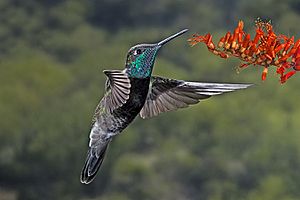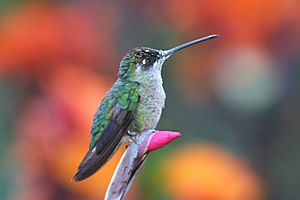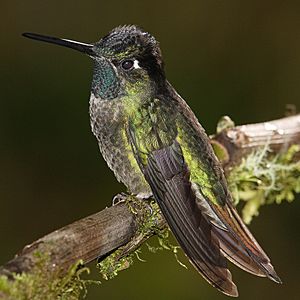Rivoli's hummingbird facts for kids
Quick facts for kids Rivoli's hummingbird |
|
|---|---|
 |
|
| Male | |
 |
|
| Female | |
| Conservation status | |
| Scientific classification | |
| Genus: |
Eugenes
|
| Species: |
fulgens
|
The Rivoli's hummingbird (Eugenes fulgens) is a large and beautiful hummingbird. It is also sometimes called the magnificent hummingbird. Some scientists believe there are actually two different types of this bird: one that lives in the north and one that lives in the south. The northern one is called Rivoli's hummingbird, and the southern one is called the Talamanca hummingbird.
Contents
Where Rivoli's Hummingbirds Live
Rivoli's hummingbirds live in the mountains. You can find them from the southwestern United States all the way down to Honduras and Nicaragua. They like to live near the edges and open areas of oak forests in the mountains. They usually live at high places, about 2,000 meters (about 6,500 feet) high, up to where the trees stop growing. However, you might see them at lower places if there are bird feeders around. During the time they raise their young, they often stay near ravines in the mountains of Arizona and New Mexico. They find their food in open fields where there are lots of flowers.
What Rivoli's Hummingbirds Look Like
Rivoli's hummingbirds are quite big for hummingbirds. They are about 11 to 14 centimeters (4.3 to 5.5 inches) long. They weigh about 6 to 10 grams (0.2 to 0.35 ounces). Males are usually a little bigger than females. Their wings can spread out about 18 centimeters (7 inches) wide. Among the hummingbirds found in the United States, the Rivoli's hummingbird is one of the two largest kinds. Only the blue-throated hummingbird is similar in size.
Their bill (beak) is black, long, and mostly straight, though it can be slightly curved. Both male and female birds look very dark unless the sun shines on their feathers. When the sun hits them, their feathers show off bright, shiny colors!
Male and Female Differences
The adult male Rivoli's hummingbird has a green-bronze back. Its tail is also bronzed with black tips. The top of its head is violet, and its throat has a bright blue-green patch called a gorget. The rest of its head is black, but it has a white spot right behind its eye. Its chest is green-bronze, and its belly is grayish.
The female Rivoli's hummingbird has a bronze-green back. Her belly is a dull gray color. She also has a white stripe behind her eye, just like the male. Young birds look similar to the female, but their colors are darker and more brownish.
Behavior and Diet
In the southern parts of their home range, Rivoli's hummingbirds might live near other hummingbird species that are similar in size. Sometimes, they even mix and have babies with these other species.
These hummingbirds eat nectar from many different kinds of flowers. They also eat some small insects. Male Rivoli's hummingbirds like to sit in easy-to-see spots. They are very protective of their feeding areas and will chase away other birds. Their call sounds like a rough drrrk.
Reproduction and Nesting
The female Rivoli's hummingbird does all the work of building the nest and sitting on the eggs. She lays two white eggs in her nest. The nest is shaped like a cup and is quite big. She usually builds it about three meters (about 10 feet) high, often near the end of a branch that hangs down.
Building the Nest
The female builds her nest high up in trees, often overhanging streams. The nest is an open cup. She lines the inside with soft feathers, mosses, and small leaves to make it cozy. The outside of the nest is covered with lichen and other bits of plants. She uses spider silk to hold it all together. The nest is about 5.6 centimeters (2.2 inches) wide and 4.6 centimeters (1.8 inches) deep on the outside. The inner cup, where the eggs sit, is about 3.6 centimeters (1.4 inches) wide and 2.5 centimeters (1 inch) deep.
It takes about 15 to 19 days for the eggs to hatch. After the chicks hatch, it takes another 20 to 26 days for them to grow enough to leave the nest and fly for the first time.
See also
 In Spanish: Colibrí magnífico para niños
In Spanish: Colibrí magnífico para niños



